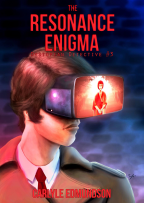4 Dangers of FTL Travel–Friday Four
- November 4th, 2016
- Posted in Genre Savvy Survival Lists . Lists . Tropes and Writing
- Write comment
 Since the dawn of spaceflight, mankind has been stalled by the limiting factor that is the speed of light. But no longer–with the advent of Faster-Than-Light (FTL) travel, the entire galaxy is now our backyard. The idea of visiting other worlds, perhaps to seek out new life and new civilizations, going boldly where no one has gone before… it’s very appealing, isn’t it? And it’s finally a reality, so you might be tempted; Earth is boring and well explored, after all, and no new intelligent species are likely to be popping up any time soon. But before you sign up to join the space exploration agency of your choice, consider all the ways this FTL trip could go horribly, horribly wrong. Warp drives, Jump drives, or Hyperspace, they all have their problems, and here are 4 of the biggest dangers of FTL travel.
Since the dawn of spaceflight, mankind has been stalled by the limiting factor that is the speed of light. But no longer–with the advent of Faster-Than-Light (FTL) travel, the entire galaxy is now our backyard. The idea of visiting other worlds, perhaps to seek out new life and new civilizations, going boldly where no one has gone before… it’s very appealing, isn’t it? And it’s finally a reality, so you might be tempted; Earth is boring and well explored, after all, and no new intelligent species are likely to be popping up any time soon. But before you sign up to join the space exploration agency of your choice, consider all the ways this FTL trip could go horribly, horribly wrong. Warp drives, Jump drives, or Hyperspace, they all have their problems, and here are 4 of the biggest dangers of FTL travel.
4. Catastrophic Failure
Alright, so technically speaking, catastrophic failure is always a possibility in any vehicle, from cars to the starship Enterprise. But if your car suffers from such a failure, there’s at least a chance you could survive. No such luck for FTL ships. The simple fact that FTL travel takes place in space would seem to be enough, but it goes beyond that–FTL, by our current understanding, is going to require some way of circumventing the basic physical laws of reality. You can accomplish this through warp bubbles, subspace, or hyperspace, but no matter the method, that’s the goal.
But these are by their very definition unnatural states, and require immense amounts of power to maintain. If even a tiny component goes wrong, your warp field can collapse, and suddenly you’re bound by the same laws of physics as the rest of the universe. And violating those laws can be messy in ways you can’t even begin to imagine; if you’re lucky, your ship will just slow down so immediately that the G forces the crew experiences will turn them into a thin red paste on the walls. The less fortunate among us might have their molecules scattered to the solar winds… or worse.
3. Lightspeed Collision
Even if your ship’s drive is functioning perfectly, there are other dangers out there… like hitting something. Obviously, this is still a problem even if you aren’t traveling FTL, but it’s one that gets exponentially worse–and I mean that literally. An object traveling near light speed, colliding with something as seemingly insignificant as a 1 kilogram space rock, can create an explosion 75 times more powerful than the largest nuclear weapon ever created. Now consider that for FTL travel, you’re going much, much faster than that. Sure, space is very, very big, and things are much farther apart than people tend to think, but you’re also covering an enormous distance to get from place to place. Traveling dozens of lightyears, you’re bound to hit a small pebble or speck of dust at some point; maybe the family you left behind on Earth will be able to see the flash of light from your ship exploding into a miniature supernova in a few years.
Often times ships are equipped with a deflector shield or something similar, to help divert such obstacles before they can strike the ship, but with as many uses as your average deflector dish has, I’m not so sure I’d be willing to trust it. And who knows how objects you might encounter in subspace/hyperspace will react…
2. Jump Fragged
“So what?” you say, “I don’t use those messy warp drives. We’ve got a fancy Jump Drive. We basically just teleport the whole ship from place to place instantly.”
That’s great, and I admit that you probably won’t collide with something when using your Jump drive there. But you have a much, much worse problem to face, and that’s materializing INTO something. After all, you said it yourself–it’s basically teleportation, and you have to make sure when teleporting that nothing is standing in your way at the destination, or things get ugly. But once again, this is where that distance you’re traveling becomes an issue. Even a “small” jump of just one lightyear is probably going to be way, way outside your sensor range, so how can you be sure of what’s waiting for you at the other side? Planets, asteroids, moons… hopefully you’re smart enough to avoid jumping into a star, because that would almost certainly be the most horrifying fate by far. While the jump itself might be instantaneous, there’s a huge number of calculations that have to be done beforehand to ensure you rematerialize on the other side properly, which makes it useless if you have to flee quickly (doubly so if you’re fleeing from cybernetic lifeforms with a grudge).
1. Trapped in Hyperspace
That just leaves us with the hyperspace/subspace method of FTL travel, doesn’t it? These remove you from normal space, so no worries about the rules suddenly changing; there’s rarely anything to run into, as a lot of the time hyperspace is inexplicably empty; and depending on how it functions, you can check very carefully before emerging into normal space, so no risk of getting fragged inside a star. But hyperspace isn’t always a fun place to be–sometimes there are things in there, even living things, that can be truly terrifying to behold. And all the laws of physics being inherently different means is that this is one place you can honestly say that Man was not meant to be. In particularly harsh levels of hyperspace, just spending time there can be enough to drive you to madness–human or not.
With that in mind, it’s obviously a top priority to spend as little time exposing yourself to the alien nature of hyperspace as possible, and how that goes wrong is obvious. If you’re using hyperspace gates to get around, then an outside party could easily trap you in this other dimension by destroying the gates that maintain the connection to our world. Mechanical failure may not kill you as fast as it would with a warp drive, but suffering in a realm where things as fundamental as the speed of light no longer apply will leave you wishing it had. And God help you if this hyperspace is lacking a comparable dimension of time, or this suffering could last untold eons…
You know what? Maybe Earth’s not so bad after all.
That’s all for this week. Any other horrific outcomes or unimaginable dangers of FTL travel you can think of? Let me know in the comments, or on Twitter @RetroPhaseShift. This weekend only, you can pick up my book Eidolon for just $0.99. No faster-than-light travel here, but if you like hardboiled adventures in a cyberpunk future, give it a shot. And for less than a dollar, why not give it a shot either way?








i think you covered everything — ive been trying to come up with a 5th mode of ftl and am drawing a blank. what does the tardis do? a version of #2?
A time machine is a fundamentally different sort of thing, even if it can effectively be used the same way. Almost by definition, a time machine must be capable of traveling in space–after all, if it didn’t at least keep up with the Earth’s orbit, you’d simply emerge 50 years in the future, at a point in orbit around the sun where the Earth *would* have been 50 years ago. Your Delorean might be pretty sweet, but I doubt it’s airtight, and good luck accelerating to 88 mph in the void.
That does mean, however, that you can use a time machine in a clever way to travel through space rapidly–simply travel 1 second into the future, to a location very far away. To an outside observer, it would certainly look like a blink drive (the Doctor does this from time to time). However, the TARDIS does travel through the Time Vortex (as seen in the credits) and that’s effectively a form of subspace or hyperspace, so from a practical perspective it’s somewhere between the two.